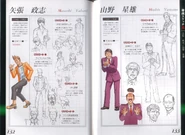No edit summary |
No edit summary |
||
| Line 73: | Line 73: | ||
* He is the only "minor" guilty character to reappear after his verdict, as well as the only one to do so outside of the game in which he appeared. [[Morgan Fey]] plays a major role in the ''[[Bridge to the Turnabout]]'', but does not appear in person. Also, she was only an accomplice to a crime and not a killer herself. |
* He is the only "minor" guilty character to reappear after his verdict, as well as the only one to do so outside of the game in which he appeared. [[Morgan Fey]] plays a major role in the ''[[Bridge to the Turnabout]]'', but does not appear in person. Also, she was only an accomplice to a crime and not a killer herself. |
||
| − | * His appearance in ''The Imprisoned Turnabout'' seems to suggest that not everyone convicted of murder in the ''Ace Attorney'' series is given a life sentence or the death penalty, as it's indicated that he would have been eligible for parole shortly after the case if not for him being Miwa's accomplice. This is consistent with real-life, where murders committed in the spur-of-the-moment are generally punished less severely than those that are premeditated. |
+ | * His appearance in ''The Imprisoned Turnabout'' seems to suggest that not everyone convicted of murder in the ''Ace Attorney'' series is given a life sentence or the death penalty, as it's indicated that he would have been eligible for parole shortly after the case if not for him being Miwa's accomplice. This is consistent with real-life, where murders committed in the spur-of-the-moment are generally punished less severely than those that are premeditated. In fact, given the relatively short amount of time that Sahwit served (around 2 years, 9 months) before his near-parole, it's possible that he was convicted of a lesser crime such as voluntary manslaughter, as the first game does not indicate that he actively intended to kill Cindy Stone. |
* He is the only guilty character to speak during a credits/epilogue sequence, if [[Godot]]'s "[[Objection!]]" voice clip at the end of ''[[Phoenix Wright: Ace Attorney: Trials and Tribulations]]'' is not included. |
* He is the only guilty character to speak during a credits/epilogue sequence, if [[Godot]]'s "[[Objection!]]" voice clip at the end of ''[[Phoenix Wright: Ace Attorney: Trials and Tribulations]]'' is not included. |
||
Revision as of 13:16, 2 July 2014
| This article contains information about Ace Attorney media that has been released only in Japan. | |
|---|---|
|
The information in this article comes from a game, demo, or other media that has been released in Japan, but not in any predominantly English-speaking country. The subject of this article has not been officially revealed for English versions of this media. English versions of this content are only available through unofficial translations. More information on this can be found here. If you have personal experience with the item of media in question, you can help the Ace Attorney Wiki by improving on this article. Please heed the manual of style when adding information. | |
| We need more pieces to finish this puzzle. | |
|---|---|

|
This article is under construction. While it is not short, it still needs expansion as outlined in the manual of style. The article most likely needs expansion near the end of the tagged section or sections. |
| Frank Sahwit |
| Y-you with your "objections", and your "evidence"... Just who do you think you are!? |
Frank Sahwit was the sole witness in the murder of Cindy Stone, the first case of Phoenix Wright. He was a common burglar who pretended to sell newspapers as a front for snooping out new houses from which to steal.
Murder of Stone
- Main article: The First Turnabout

Sahwit's mugshot in 2016.
During one of his burglaries, Sahwit was caught in the act by the owner of the apartment, Cindy Stone. He picked up the nearest thing he could find, a clock-statue of "The Thinker", and hit her over the head with it. The clock then spoke the time, which Sahwit believed was the real time. She died of blood loss, and Sahwit decided to frame her boyfriend Larry Butz, who had visited her apartment on the day of the murder.
The real Sahwit.
Sahwit was called as the sole witness to the murder. His testimony was full of holes that the new defense attorney, Phoenix Wright, could exploit, even giving testimony that contradicted his earlier statements, and he soon reached a point in which he was accused of the murder. He then switched from his sycophantic persona into his real, rage-filled nature. He flung his toupée at Wright and shouted at him that he had one final question. He said that Wright could not prove that the clock was telling the correct time at the time of the murder, but Wright - with the aid of Mia Fey - explained that the victim had gone to France the day before the murder. Sahwit broke down on the stand; he hyperventilated and collapsed. Butz was subsequently declared not guilty, Wright's career took off, and Sahwit was imprisoned.
Imprisonment
- Main article: The Imprisoned Turnabout

Sahwit's sycophantic façade once again disappears.
Sahwit was convicted of the murder of Cindy Stone and imprisoned, although he received a comparatively light sentence since the murder wasn't premeditated. For three years he lived as a model prisoner and began training as an animal groomer for the therapy animals living in the prison. He helped the prison warden Marī Miwa smuggle items into the prison by throwing the circuit breaker to power down the electric fence between the detention center and prison. Sahwit cooperated in exchange for his prison bracelet, which would give an electric shock to prisoners moving about unattended, being broken. This allowed him to move about the prison as he liked.
One day, in Workshop B, he was putting a mudpack on Shūji Orinaka's pet polar bear cub Mark when his "client" escaped. While following the animal, Sahwit peeked into Workshop A, only to see the imprisoned assassin Ryōken Hōinbō's large black dog Kuro biting into the neck of a dead Manosuke Naitō. After the dog left, Sahwit sneaked into the room to see if there was anything of value on the corpse, but he had to leave before he could take anything as there was an imminent prison roll-call. He returned to Workshop B and let out a scream to make it seem that he had only just found the body.
Unfortunately for Sahwit, the cosy set-up he had with the warden was ruined with the arrival of Miles Edgeworth, who was acting as Tateyuki Shigaraki's assistant. Edgeworth used his calm interrogation methods to reveal what Sahwit knew about the murder. As before with Wright, Sahwit eventually became so enraged at being backed into a corner that he threw his toupée at Edgeworth.
Edgeworth eventually revealed that it had been prison warden Miwa who had killed Naitō. For his role as an accomplice to Miwa, Sahwit's prison sentence was extended.
Personality
Sahwit was smarmy, sycophantic, and nosy, but hid a deep anger problem. He also had a habit of telling fairly transparent lies, then getting angry when he was challenged.
Name
- His Japanese name, "Yamano Hoshio" (山野星雄), may be a play on the phrase "yama no hoshi", which literally means "star of the mountain". This may be because, during the trial, he says "If there's a mountain, someone will climb it", in reference to him being compelled to "peek" at Stone's crime scene. "Yama" and "hoshi" are also Japanese police slang words for a likely perpetrator, similar to the word "perp".
- "Frank Sahwit" literally reads as "frank saw it". Ironically, he is not really a frank person, seeing as he lies a lot, and although he actually committed the crime, he didn't "see it" properly, leading to his hole-filled testimony. Wright made a joke out of the name, calling Sahwit "Mr. Did It" after he had proven that Sahwit had killed Stone.
- "Frank Khavu" comes from the French phrase "frank qu'a vu", meaning "frank who saw it".
Development
- The mole on his forehead was apparently added as a mark of guilt.
- The developers added him to The Imprisoned Turnabout as a way of celebrating the Ace Attorney series' 10th anniversary, noting that any long-time player would associate him with the series.
- He is the only "minor" guilty character to reappear after his verdict, as well as the only one to do so outside of the game in which he appeared. Morgan Fey plays a major role in the Bridge to the Turnabout, but does not appear in person. Also, she was only an accomplice to a crime and not a killer herself.
- His appearance in The Imprisoned Turnabout seems to suggest that not everyone convicted of murder in the Ace Attorney series is given a life sentence or the death penalty, as it's indicated that he would have been eligible for parole shortly after the case if not for him being Miwa's accomplice. This is consistent with real-life, where murders committed in the spur-of-the-moment are generally punished less severely than those that are premeditated. In fact, given the relatively short amount of time that Sahwit served (around 2 years, 9 months) before his near-parole, it's possible that he was convicted of a lesser crime such as voluntary manslaughter, as the first game does not indicate that he actively intended to kill Cindy Stone.
- He is the only guilty character to speak during a credits/epilogue sequence, if Godot's "Objection!" voice clip at the end of Phoenix Wright: Ace Attorney: Trials and Tribulations is not included.

Sahwit in 2019.
- His mugshot in The Imprisoned Turnabout is almost the same as the one used in his previous appearance. The only differences are his attire and that his head is a little smaller. However, his profile states that he is 47 years old, despite The Imprisoned Turnabout being only three years on from The First Turnabout, where his profile stated that he was 36 at the time. However, in Phoenix Wright: Ace Attorney Trilogy HD, his age is listed as 44, fitting with his age in Gyakuten Kenji 2.















